Students' Internet Usage: Impact on Education - University Report
VerifiedAdded on 2022/10/19
|10
|2853
|392
Report
AI Summary
This report investigates the role of technology, specifically the internet, in the education sector and its impact on students' daily activities and academic performance. It explores the ways students utilize internet services for educational purposes, identifying the effectiveness and efficiency of accessing online resources and the utility perceptions surrounding internet accessibility, including product, price, place, and promotion. The literature review highlights the increasing use of the internet in teaching and learning, the shift from traditional library research to online information retrieval, and the availability of online courses and research tools. The methodology employs a positivism research philosophy with a deductive approach and explanatory research design, utilizing primary data collected through questionnaires. The findings reveal that while internet services are essential, not all students actively use them for academic purposes, with some relying on online education. The report concludes that internet services are widely used by students, offering an independent platform for sharing queries and ideas, and that students benefit from increased internet usage. The report also provides references from various academic sources.
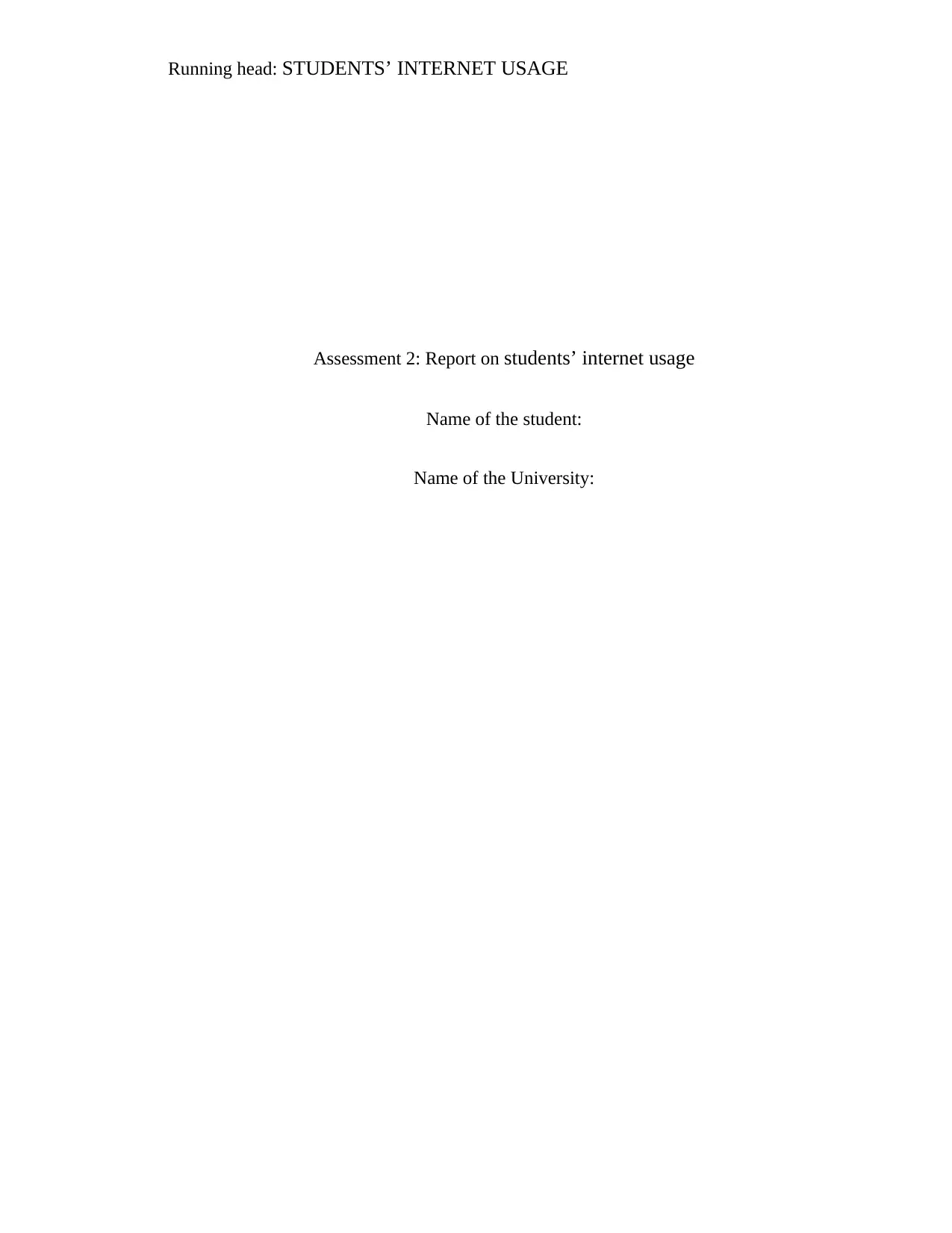
Running head: STUDENTS’ INTERNET USAGE
Assessment 2: Report on students’ internet usage
Name of the student:
Name of the University:
Assessment 2: Report on students’ internet usage
Name of the student:
Name of the University:
Secure Best Marks with AI Grader
Need help grading? Try our AI Grader for instant feedback on your assignments.
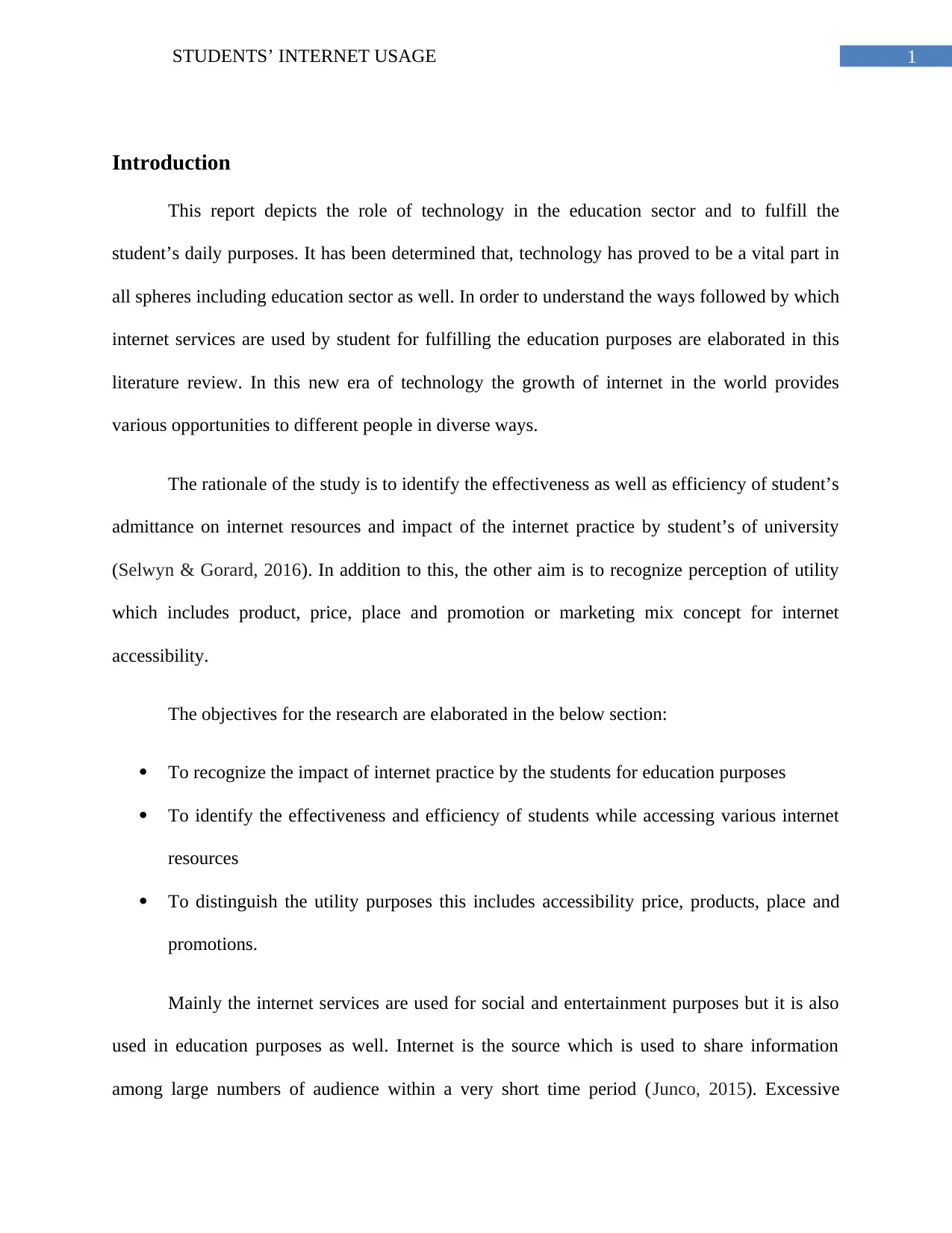
1STUDENTS’ INTERNET USAGE
Introduction
This report depicts the role of technology in the education sector and to fulfill the
student’s daily purposes. It has been determined that, technology has proved to be a vital part in
all spheres including education sector as well. In order to understand the ways followed by which
internet services are used by student for fulfilling the education purposes are elaborated in this
literature review. In this new era of technology the growth of internet in the world provides
various opportunities to different people in diverse ways.
The rationale of the study is to identify the effectiveness as well as efficiency of student’s
admittance on internet resources and impact of the internet practice by student’s of university
(Selwyn & Gorard, 2016). In addition to this, the other aim is to recognize perception of utility
which includes product, price, place and promotion or marketing mix concept for internet
accessibility.
The objectives for the research are elaborated in the below section:
To recognize the impact of internet practice by the students for education purposes
To identify the effectiveness and efficiency of students while accessing various internet
resources
To distinguish the utility purposes this includes accessibility price, products, place and
promotions.
Mainly the internet services are used for social and entertainment purposes but it is also
used in education purposes as well. Internet is the source which is used to share information
among large numbers of audience within a very short time period (Junco, 2015). Excessive
Introduction
This report depicts the role of technology in the education sector and to fulfill the
student’s daily purposes. It has been determined that, technology has proved to be a vital part in
all spheres including education sector as well. In order to understand the ways followed by which
internet services are used by student for fulfilling the education purposes are elaborated in this
literature review. In this new era of technology the growth of internet in the world provides
various opportunities to different people in diverse ways.
The rationale of the study is to identify the effectiveness as well as efficiency of student’s
admittance on internet resources and impact of the internet practice by student’s of university
(Selwyn & Gorard, 2016). In addition to this, the other aim is to recognize perception of utility
which includes product, price, place and promotion or marketing mix concept for internet
accessibility.
The objectives for the research are elaborated in the below section:
To recognize the impact of internet practice by the students for education purposes
To identify the effectiveness and efficiency of students while accessing various internet
resources
To distinguish the utility purposes this includes accessibility price, products, place and
promotions.
Mainly the internet services are used for social and entertainment purposes but it is also
used in education purposes as well. Internet is the source which is used to share information
among large numbers of audience within a very short time period (Junco, 2015). Excessive
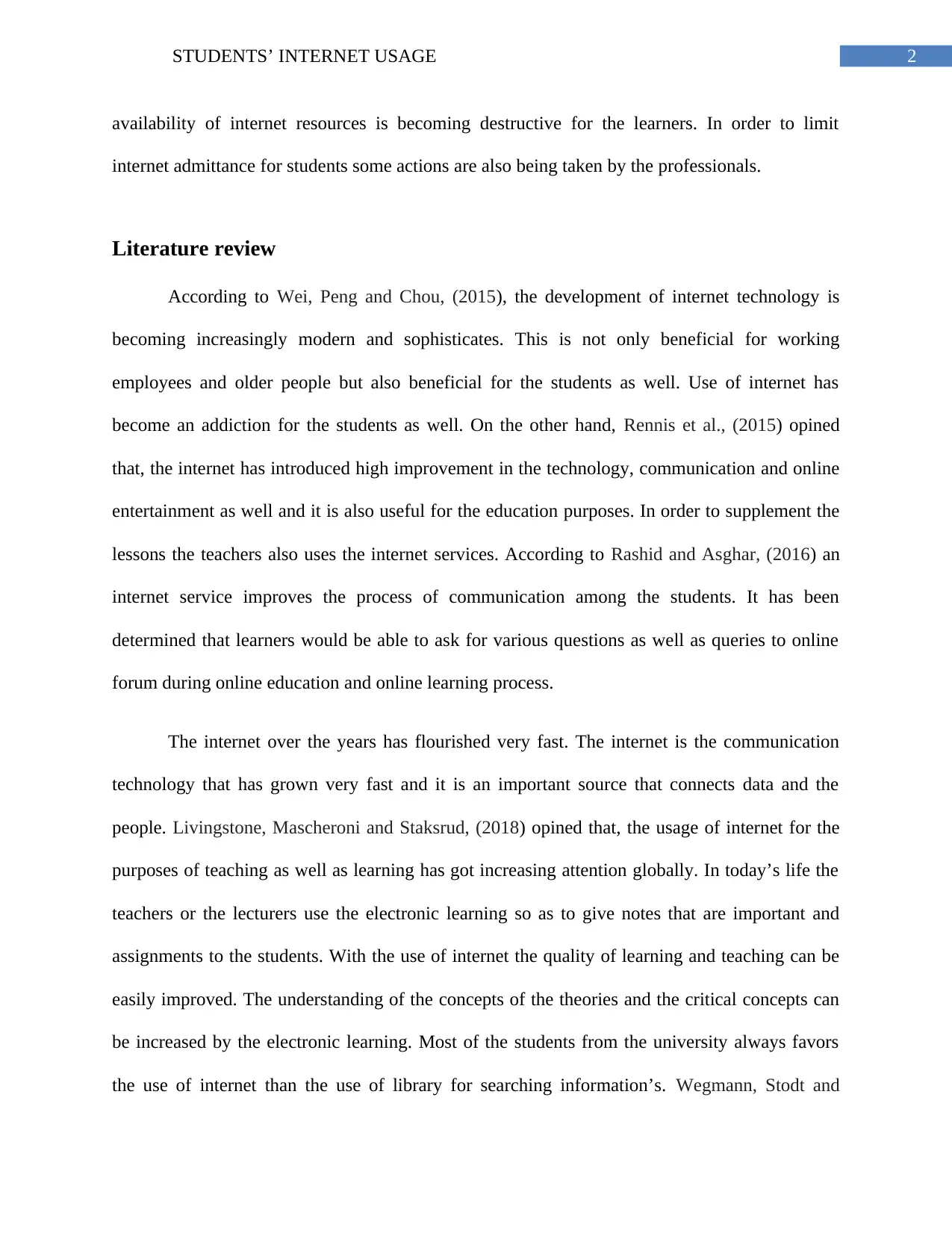
2STUDENTS’ INTERNET USAGE
availability of internet resources is becoming destructive for the learners. In order to limit
internet admittance for students some actions are also being taken by the professionals.
Literature review
According to Wei, Peng and Chou, (2015), the development of internet technology is
becoming increasingly modern and sophisticates. This is not only beneficial for working
employees and older people but also beneficial for the students as well. Use of internet has
become an addiction for the students as well. On the other hand, Rennis et al., (2015) opined
that, the internet has introduced high improvement in the technology, communication and online
entertainment as well and it is also useful for the education purposes. In order to supplement the
lessons the teachers also uses the internet services. According to Rashid and Asghar, (2016) an
internet service improves the process of communication among the students. It has been
determined that learners would be able to ask for various questions as well as queries to online
forum during online education and online learning process.
The internet over the years has flourished very fast. The internet is the communication
technology that has grown very fast and it is an important source that connects data and the
people. Livingstone, Mascheroni and Staksrud, (2018) opined that, the usage of internet for the
purposes of teaching as well as learning has got increasing attention globally. In today’s life the
teachers or the lecturers use the electronic learning so as to give notes that are important and
assignments to the students. With the use of internet the quality of learning and teaching can be
easily improved. The understanding of the concepts of the theories and the critical concepts can
be increased by the electronic learning. Most of the students from the university always favors
the use of internet than the use of library for searching information’s. Wegmann, Stodt and
availability of internet resources is becoming destructive for the learners. In order to limit
internet admittance for students some actions are also being taken by the professionals.
Literature review
According to Wei, Peng and Chou, (2015), the development of internet technology is
becoming increasingly modern and sophisticates. This is not only beneficial for working
employees and older people but also beneficial for the students as well. Use of internet has
become an addiction for the students as well. On the other hand, Rennis et al., (2015) opined
that, the internet has introduced high improvement in the technology, communication and online
entertainment as well and it is also useful for the education purposes. In order to supplement the
lessons the teachers also uses the internet services. According to Rashid and Asghar, (2016) an
internet service improves the process of communication among the students. It has been
determined that learners would be able to ask for various questions as well as queries to online
forum during online education and online learning process.
The internet over the years has flourished very fast. The internet is the communication
technology that has grown very fast and it is an important source that connects data and the
people. Livingstone, Mascheroni and Staksrud, (2018) opined that, the usage of internet for the
purposes of teaching as well as learning has got increasing attention globally. In today’s life the
teachers or the lecturers use the electronic learning so as to give notes that are important and
assignments to the students. With the use of internet the quality of learning and teaching can be
easily improved. The understanding of the concepts of the theories and the critical concepts can
be increased by the electronic learning. Most of the students from the university always favors
the use of internet than the use of library for searching information’s. Wegmann, Stodt and
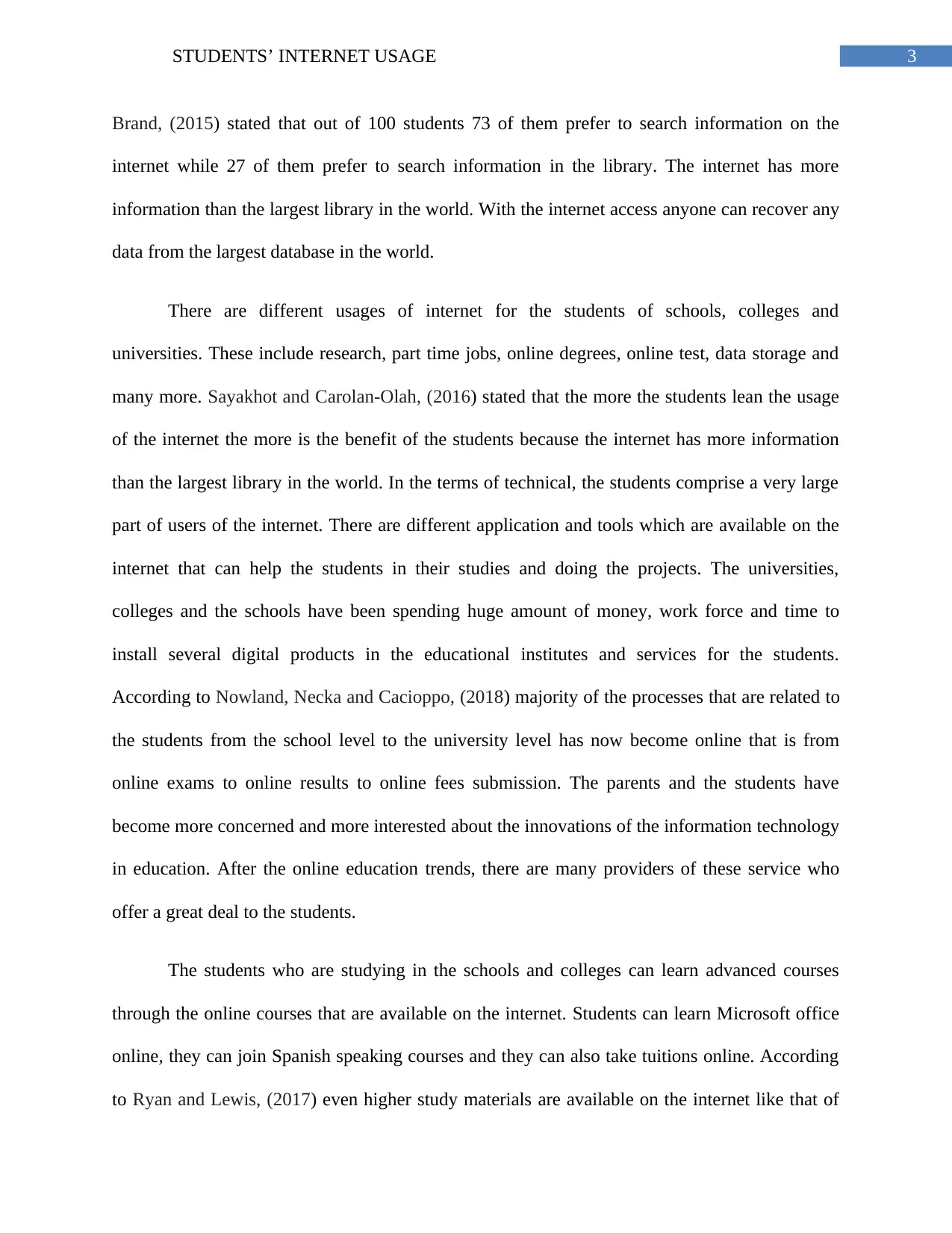
3STUDENTS’ INTERNET USAGE
Brand, (2015) stated that out of 100 students 73 of them prefer to search information on the
internet while 27 of them prefer to search information in the library. The internet has more
information than the largest library in the world. With the internet access anyone can recover any
data from the largest database in the world.
There are different usages of internet for the students of schools, colleges and
universities. These include research, part time jobs, online degrees, online test, data storage and
many more. Sayakhot and Carolan-Olah, (2016) stated that the more the students lean the usage
of the internet the more is the benefit of the students because the internet has more information
than the largest library in the world. In the terms of technical, the students comprise a very large
part of users of the internet. There are different application and tools which are available on the
internet that can help the students in their studies and doing the projects. The universities,
colleges and the schools have been spending huge amount of money, work force and time to
install several digital products in the educational institutes and services for the students.
According to Nowland, Necka and Cacioppo, (2018) majority of the processes that are related to
the students from the school level to the university level has now become online that is from
online exams to online results to online fees submission. The parents and the students have
become more concerned and more interested about the innovations of the information technology
in education. After the online education trends, there are many providers of these service who
offer a great deal to the students.
The students who are studying in the schools and colleges can learn advanced courses
through the online courses that are available on the internet. Students can learn Microsoft office
online, they can join Spanish speaking courses and they can also take tuitions online. According
to Ryan and Lewis, (2017) even higher study materials are available on the internet like that of
Brand, (2015) stated that out of 100 students 73 of them prefer to search information on the
internet while 27 of them prefer to search information in the library. The internet has more
information than the largest library in the world. With the internet access anyone can recover any
data from the largest database in the world.
There are different usages of internet for the students of schools, colleges and
universities. These include research, part time jobs, online degrees, online test, data storage and
many more. Sayakhot and Carolan-Olah, (2016) stated that the more the students lean the usage
of the internet the more is the benefit of the students because the internet has more information
than the largest library in the world. In the terms of technical, the students comprise a very large
part of users of the internet. There are different application and tools which are available on the
internet that can help the students in their studies and doing the projects. The universities,
colleges and the schools have been spending huge amount of money, work force and time to
install several digital products in the educational institutes and services for the students.
According to Nowland, Necka and Cacioppo, (2018) majority of the processes that are related to
the students from the school level to the university level has now become online that is from
online exams to online results to online fees submission. The parents and the students have
become more concerned and more interested about the innovations of the information technology
in education. After the online education trends, there are many providers of these service who
offer a great deal to the students.
The students who are studying in the schools and colleges can learn advanced courses
through the online courses that are available on the internet. Students can learn Microsoft office
online, they can join Spanish speaking courses and they can also take tuitions online. According
to Ryan and Lewis, (2017) even higher study materials are available on the internet like that of
Secure Best Marks with AI Grader
Need help grading? Try our AI Grader for instant feedback on your assignments.
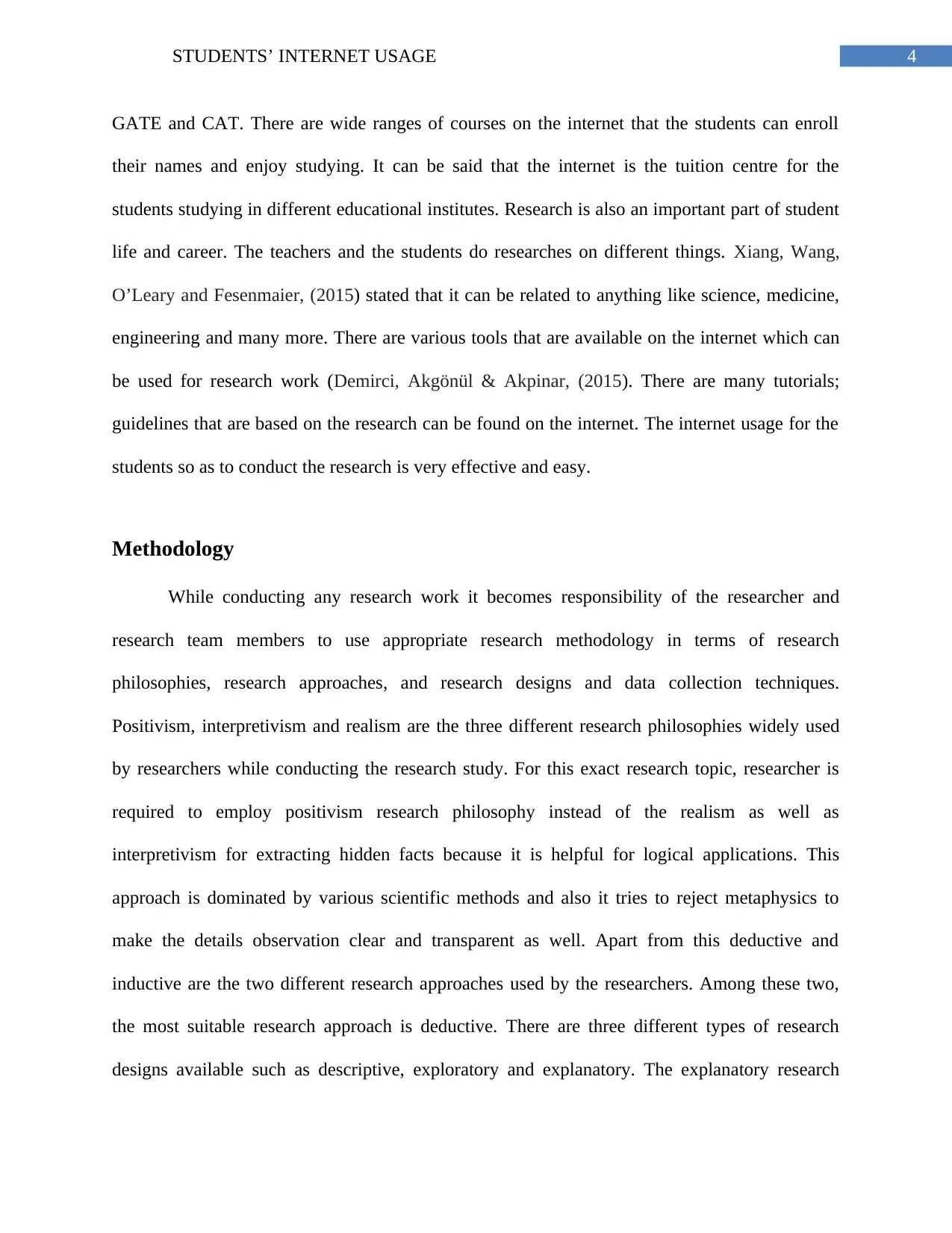
4STUDENTS’ INTERNET USAGE
GATE and CAT. There are wide ranges of courses on the internet that the students can enroll
their names and enjoy studying. It can be said that the internet is the tuition centre for the
students studying in different educational institutes. Research is also an important part of student
life and career. The teachers and the students do researches on different things. Xiang, Wang,
O’Leary and Fesenmaier, (2015) stated that it can be related to anything like science, medicine,
engineering and many more. There are various tools that are available on the internet which can
be used for research work (Demirci, Akgönül & Akpinar, (2015). There are many tutorials;
guidelines that are based on the research can be found on the internet. The internet usage for the
students so as to conduct the research is very effective and easy.
Methodology
While conducting any research work it becomes responsibility of the researcher and
research team members to use appropriate research methodology in terms of research
philosophies, research approaches, and research designs and data collection techniques.
Positivism, interpretivism and realism are the three different research philosophies widely used
by researchers while conducting the research study. For this exact research topic, researcher is
required to employ positivism research philosophy instead of the realism as well as
interpretivism for extracting hidden facts because it is helpful for logical applications. This
approach is dominated by various scientific methods and also it tries to reject metaphysics to
make the details observation clear and transparent as well. Apart from this deductive and
inductive are the two different research approaches used by the researchers. Among these two,
the most suitable research approach is deductive. There are three different types of research
designs available such as descriptive, exploratory and explanatory. The explanatory research
GATE and CAT. There are wide ranges of courses on the internet that the students can enroll
their names and enjoy studying. It can be said that the internet is the tuition centre for the
students studying in different educational institutes. Research is also an important part of student
life and career. The teachers and the students do researches on different things. Xiang, Wang,
O’Leary and Fesenmaier, (2015) stated that it can be related to anything like science, medicine,
engineering and many more. There are various tools that are available on the internet which can
be used for research work (Demirci, Akgönül & Akpinar, (2015). There are many tutorials;
guidelines that are based on the research can be found on the internet. The internet usage for the
students so as to conduct the research is very effective and easy.
Methodology
While conducting any research work it becomes responsibility of the researcher and
research team members to use appropriate research methodology in terms of research
philosophies, research approaches, and research designs and data collection techniques.
Positivism, interpretivism and realism are the three different research philosophies widely used
by researchers while conducting the research study. For this exact research topic, researcher is
required to employ positivism research philosophy instead of the realism as well as
interpretivism for extracting hidden facts because it is helpful for logical applications. This
approach is dominated by various scientific methods and also it tries to reject metaphysics to
make the details observation clear and transparent as well. Apart from this deductive and
inductive are the two different research approaches used by the researchers. Among these two,
the most suitable research approach is deductive. There are three different types of research
designs available such as descriptive, exploratory and explanatory. The explanatory research
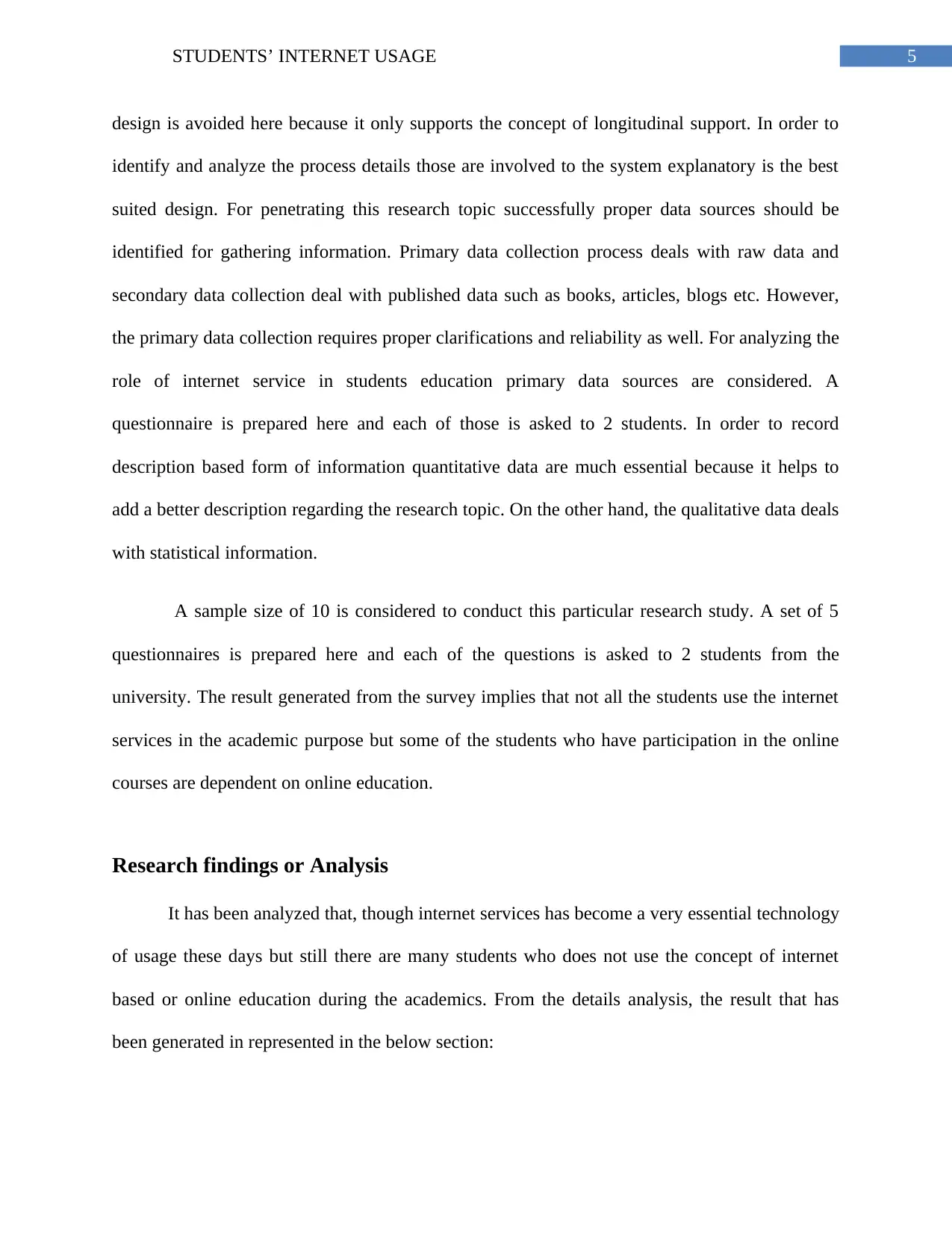
5STUDENTS’ INTERNET USAGE
design is avoided here because it only supports the concept of longitudinal support. In order to
identify and analyze the process details those are involved to the system explanatory is the best
suited design. For penetrating this research topic successfully proper data sources should be
identified for gathering information. Primary data collection process deals with raw data and
secondary data collection deal with published data such as books, articles, blogs etc. However,
the primary data collection requires proper clarifications and reliability as well. For analyzing the
role of internet service in students education primary data sources are considered. A
questionnaire is prepared here and each of those is asked to 2 students. In order to record
description based form of information quantitative data are much essential because it helps to
add a better description regarding the research topic. On the other hand, the qualitative data deals
with statistical information.
A sample size of 10 is considered to conduct this particular research study. A set of 5
questionnaires is prepared here and each of the questions is asked to 2 students from the
university. The result generated from the survey implies that not all the students use the internet
services in the academic purpose but some of the students who have participation in the online
courses are dependent on online education.
Research findings or Analysis
It has been analyzed that, though internet services has become a very essential technology
of usage these days but still there are many students who does not use the concept of internet
based or online education during the academics. From the details analysis, the result that has
been generated in represented in the below section:
design is avoided here because it only supports the concept of longitudinal support. In order to
identify and analyze the process details those are involved to the system explanatory is the best
suited design. For penetrating this research topic successfully proper data sources should be
identified for gathering information. Primary data collection process deals with raw data and
secondary data collection deal with published data such as books, articles, blogs etc. However,
the primary data collection requires proper clarifications and reliability as well. For analyzing the
role of internet service in students education primary data sources are considered. A
questionnaire is prepared here and each of those is asked to 2 students. In order to record
description based form of information quantitative data are much essential because it helps to
add a better description regarding the research topic. On the other hand, the qualitative data deals
with statistical information.
A sample size of 10 is considered to conduct this particular research study. A set of 5
questionnaires is prepared here and each of the questions is asked to 2 students from the
university. The result generated from the survey implies that not all the students use the internet
services in the academic purpose but some of the students who have participation in the online
courses are dependent on online education.
Research findings or Analysis
It has been analyzed that, though internet services has become a very essential technology
of usage these days but still there are many students who does not use the concept of internet
based or online education during the academics. From the details analysis, the result that has
been generated in represented in the below section:
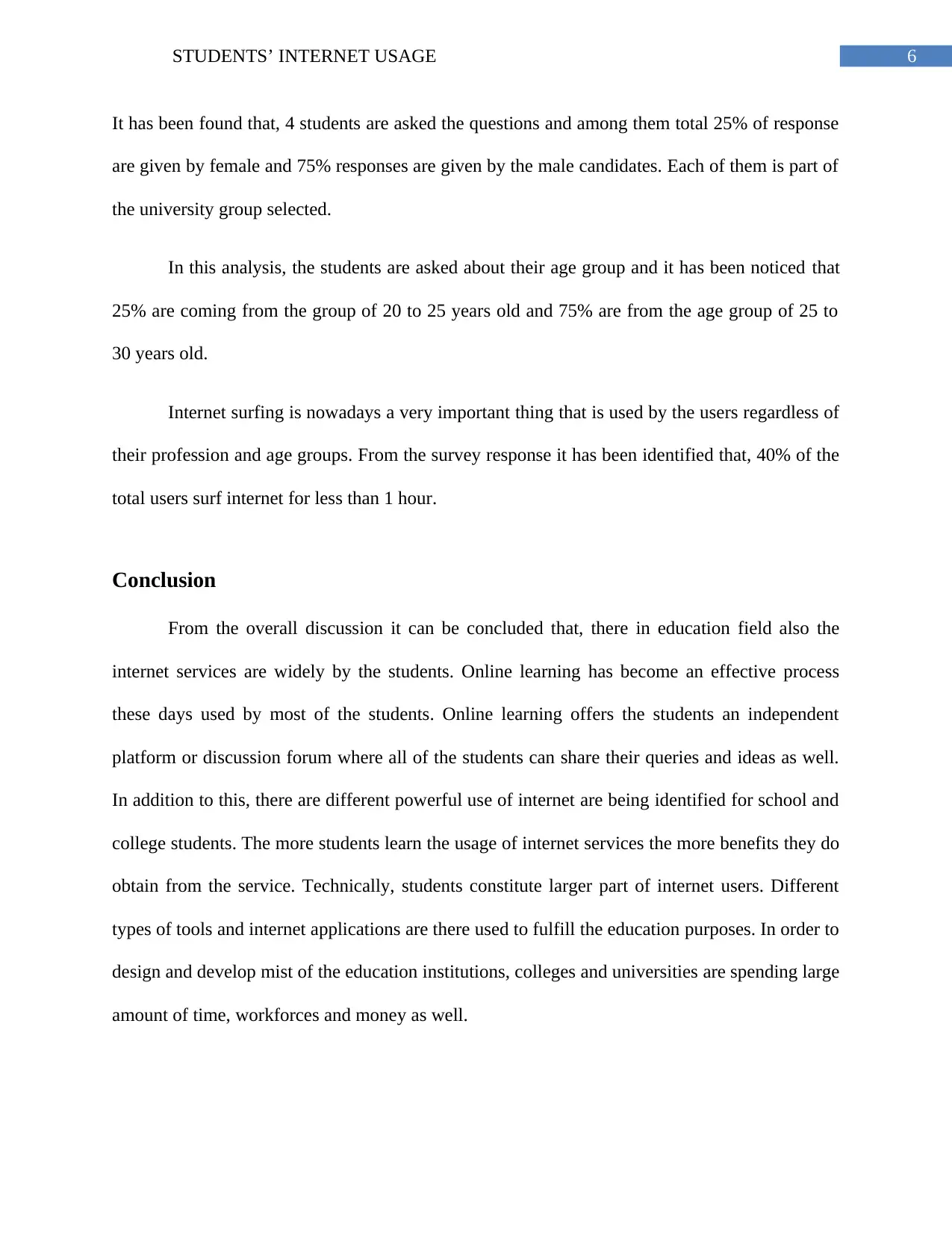
6STUDENTS’ INTERNET USAGE
It has been found that, 4 students are asked the questions and among them total 25% of response
are given by female and 75% responses are given by the male candidates. Each of them is part of
the university group selected.
In this analysis, the students are asked about their age group and it has been noticed that
25% are coming from the group of 20 to 25 years old and 75% are from the age group of 25 to
30 years old.
Internet surfing is nowadays a very important thing that is used by the users regardless of
their profession and age groups. From the survey response it has been identified that, 40% of the
total users surf internet for less than 1 hour.
Conclusion
From the overall discussion it can be concluded that, there in education field also the
internet services are widely by the students. Online learning has become an effective process
these days used by most of the students. Online learning offers the students an independent
platform or discussion forum where all of the students can share their queries and ideas as well.
In addition to this, there are different powerful use of internet are being identified for school and
college students. The more students learn the usage of internet services the more benefits they do
obtain from the service. Technically, students constitute larger part of internet users. Different
types of tools and internet applications are there used to fulfill the education purposes. In order to
design and develop mist of the education institutions, colleges and universities are spending large
amount of time, workforces and money as well.
It has been found that, 4 students are asked the questions and among them total 25% of response
are given by female and 75% responses are given by the male candidates. Each of them is part of
the university group selected.
In this analysis, the students are asked about their age group and it has been noticed that
25% are coming from the group of 20 to 25 years old and 75% are from the age group of 25 to
30 years old.
Internet surfing is nowadays a very important thing that is used by the users regardless of
their profession and age groups. From the survey response it has been identified that, 40% of the
total users surf internet for less than 1 hour.
Conclusion
From the overall discussion it can be concluded that, there in education field also the
internet services are widely by the students. Online learning has become an effective process
these days used by most of the students. Online learning offers the students an independent
platform or discussion forum where all of the students can share their queries and ideas as well.
In addition to this, there are different powerful use of internet are being identified for school and
college students. The more students learn the usage of internet services the more benefits they do
obtain from the service. Technically, students constitute larger part of internet users. Different
types of tools and internet applications are there used to fulfill the education purposes. In order to
design and develop mist of the education institutions, colleges and universities are spending large
amount of time, workforces and money as well.
Paraphrase This Document
Need a fresh take? Get an instant paraphrase of this document with our AI Paraphraser
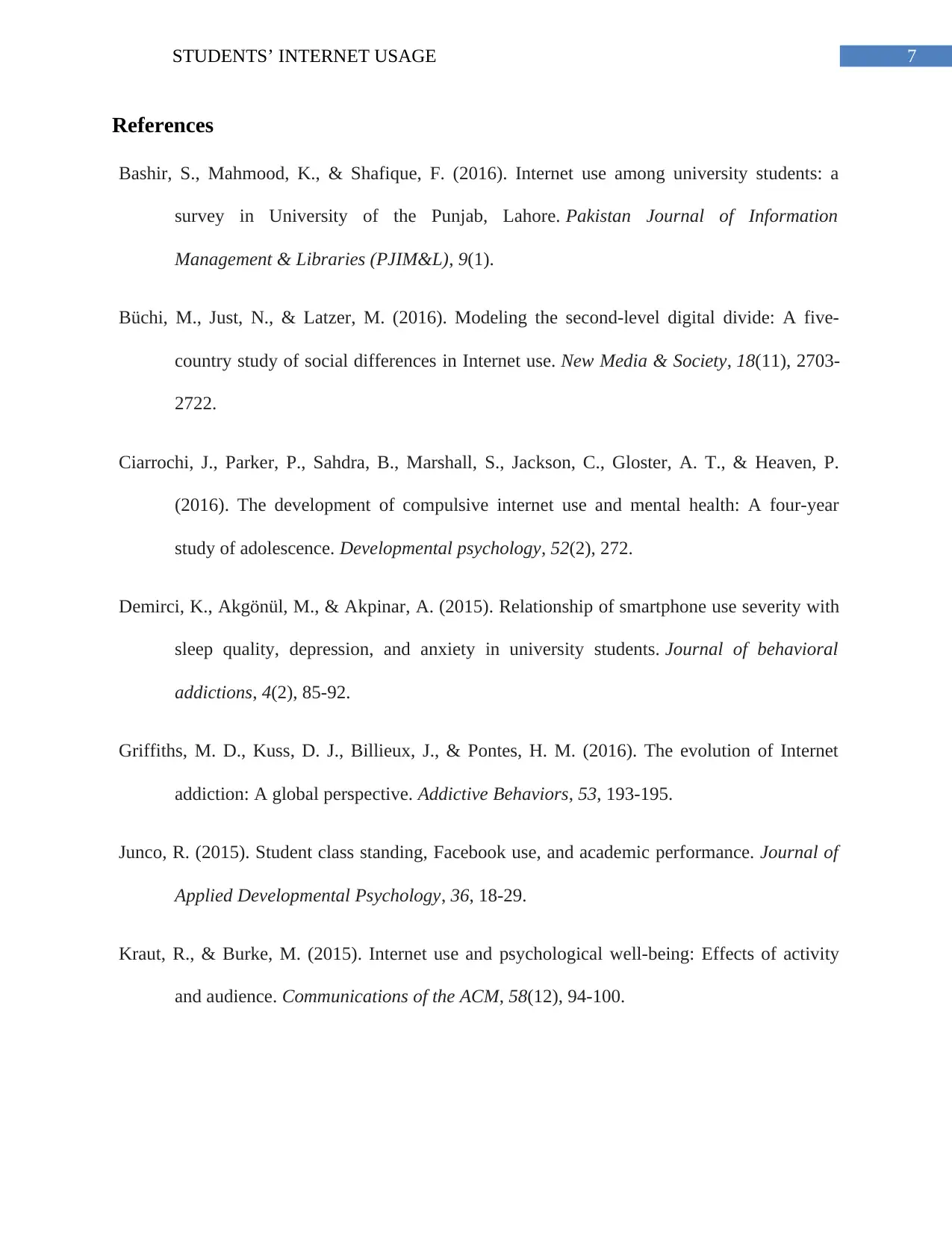
7STUDENTS’ INTERNET USAGE
References
Bashir, S., Mahmood, K., & Shafique, F. (2016). Internet use among university students: a
survey in University of the Punjab, Lahore. Pakistan Journal of Information
Management & Libraries (PJIM&L), 9(1).
Büchi, M., Just, N., & Latzer, M. (2016). Modeling the second-level digital divide: A five-
country study of social differences in Internet use. New Media & Society, 18(11), 2703-
2722.
Ciarrochi, J., Parker, P., Sahdra, B., Marshall, S., Jackson, C., Gloster, A. T., & Heaven, P.
(2016). The development of compulsive internet use and mental health: A four-year
study of adolescence. Developmental psychology, 52(2), 272.
Demirci, K., Akgönül, M., & Akpinar, A. (2015). Relationship of smartphone use severity with
sleep quality, depression, and anxiety in university students. Journal of behavioral
addictions, 4(2), 85-92.
Griffiths, M. D., Kuss, D. J., Billieux, J., & Pontes, H. M. (2016). The evolution of Internet
addiction: A global perspective. Addictive Behaviors, 53, 193-195.
Junco, R. (2015). Student class standing, Facebook use, and academic performance. Journal of
Applied Developmental Psychology, 36, 18-29.
Kraut, R., & Burke, M. (2015). Internet use and psychological well-being: Effects of activity
and audience. Communications of the ACM, 58(12), 94-100.
References
Bashir, S., Mahmood, K., & Shafique, F. (2016). Internet use among university students: a
survey in University of the Punjab, Lahore. Pakistan Journal of Information
Management & Libraries (PJIM&L), 9(1).
Büchi, M., Just, N., & Latzer, M. (2016). Modeling the second-level digital divide: A five-
country study of social differences in Internet use. New Media & Society, 18(11), 2703-
2722.
Ciarrochi, J., Parker, P., Sahdra, B., Marshall, S., Jackson, C., Gloster, A. T., & Heaven, P.
(2016). The development of compulsive internet use and mental health: A four-year
study of adolescence. Developmental psychology, 52(2), 272.
Demirci, K., Akgönül, M., & Akpinar, A. (2015). Relationship of smartphone use severity with
sleep quality, depression, and anxiety in university students. Journal of behavioral
addictions, 4(2), 85-92.
Griffiths, M. D., Kuss, D. J., Billieux, J., & Pontes, H. M. (2016). The evolution of Internet
addiction: A global perspective. Addictive Behaviors, 53, 193-195.
Junco, R. (2015). Student class standing, Facebook use, and academic performance. Journal of
Applied Developmental Psychology, 36, 18-29.
Kraut, R., & Burke, M. (2015). Internet use and psychological well-being: Effects of activity
and audience. Communications of the ACM, 58(12), 94-100.
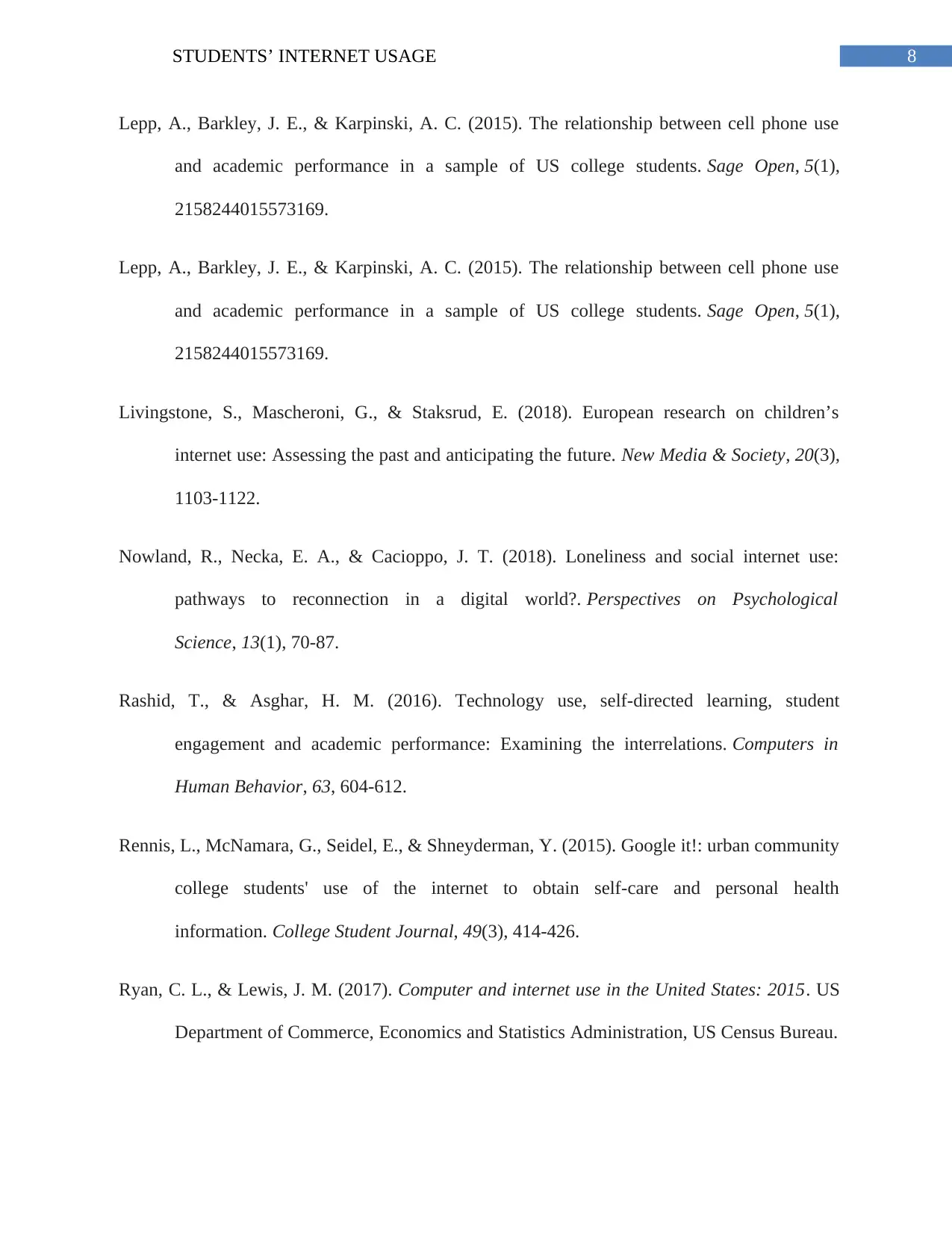
8STUDENTS’ INTERNET USAGE
Lepp, A., Barkley, J. E., & Karpinski, A. C. (2015). The relationship between cell phone use
and academic performance in a sample of US college students. Sage Open, 5(1),
2158244015573169.
Lepp, A., Barkley, J. E., & Karpinski, A. C. (2015). The relationship between cell phone use
and academic performance in a sample of US college students. Sage Open, 5(1),
2158244015573169.
Livingstone, S., Mascheroni, G., & Staksrud, E. (2018). European research on children’s
internet use: Assessing the past and anticipating the future. New Media & Society, 20(3),
1103-1122.
Nowland, R., Necka, E. A., & Cacioppo, J. T. (2018). Loneliness and social internet use:
pathways to reconnection in a digital world?. Perspectives on Psychological
Science, 13(1), 70-87.
Rashid, T., & Asghar, H. M. (2016). Technology use, self-directed learning, student
engagement and academic performance: Examining the interrelations. Computers in
Human Behavior, 63, 604-612.
Rennis, L., McNamara, G., Seidel, E., & Shneyderman, Y. (2015). Google it!: urban community
college students' use of the internet to obtain self-care and personal health
information. College Student Journal, 49(3), 414-426.
Ryan, C. L., & Lewis, J. M. (2017). Computer and internet use in the United States: 2015. US
Department of Commerce, Economics and Statistics Administration, US Census Bureau.
Lepp, A., Barkley, J. E., & Karpinski, A. C. (2015). The relationship between cell phone use
and academic performance in a sample of US college students. Sage Open, 5(1),
2158244015573169.
Lepp, A., Barkley, J. E., & Karpinski, A. C. (2015). The relationship between cell phone use
and academic performance in a sample of US college students. Sage Open, 5(1),
2158244015573169.
Livingstone, S., Mascheroni, G., & Staksrud, E. (2018). European research on children’s
internet use: Assessing the past and anticipating the future. New Media & Society, 20(3),
1103-1122.
Nowland, R., Necka, E. A., & Cacioppo, J. T. (2018). Loneliness and social internet use:
pathways to reconnection in a digital world?. Perspectives on Psychological
Science, 13(1), 70-87.
Rashid, T., & Asghar, H. M. (2016). Technology use, self-directed learning, student
engagement and academic performance: Examining the interrelations. Computers in
Human Behavior, 63, 604-612.
Rennis, L., McNamara, G., Seidel, E., & Shneyderman, Y. (2015). Google it!: urban community
college students' use of the internet to obtain self-care and personal health
information. College Student Journal, 49(3), 414-426.
Ryan, C. L., & Lewis, J. M. (2017). Computer and internet use in the United States: 2015. US
Department of Commerce, Economics and Statistics Administration, US Census Bureau.
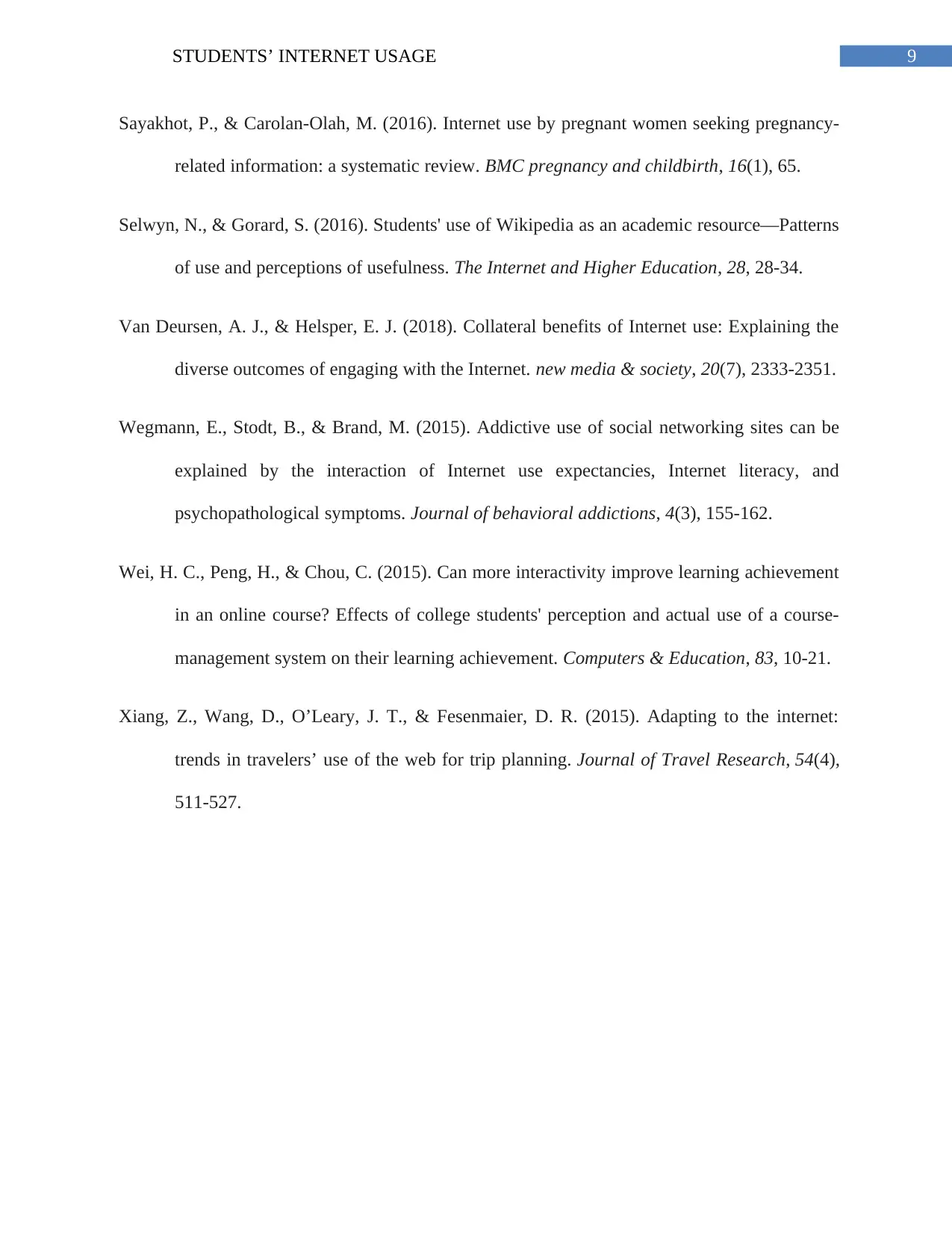
9STUDENTS’ INTERNET USAGE
Sayakhot, P., & Carolan-Olah, M. (2016). Internet use by pregnant women seeking pregnancy-
related information: a systematic review. BMC pregnancy and childbirth, 16(1), 65.
Selwyn, N., & Gorard, S. (2016). Students' use of Wikipedia as an academic resource—Patterns
of use and perceptions of usefulness. The Internet and Higher Education, 28, 28-34.
Van Deursen, A. J., & Helsper, E. J. (2018). Collateral benefits of Internet use: Explaining the
diverse outcomes of engaging with the Internet. new media & society, 20(7), 2333-2351.
Wegmann, E., Stodt, B., & Brand, M. (2015). Addictive use of social networking sites can be
explained by the interaction of Internet use expectancies, Internet literacy, and
psychopathological symptoms. Journal of behavioral addictions, 4(3), 155-162.
Wei, H. C., Peng, H., & Chou, C. (2015). Can more interactivity improve learning achievement
in an online course? Effects of college students' perception and actual use of a course-
management system on their learning achievement. Computers & Education, 83, 10-21.
Xiang, Z., Wang, D., O’Leary, J. T., & Fesenmaier, D. R. (2015). Adapting to the internet:
trends in travelers’ use of the web for trip planning. Journal of Travel Research, 54(4),
511-527.
Sayakhot, P., & Carolan-Olah, M. (2016). Internet use by pregnant women seeking pregnancy-
related information: a systematic review. BMC pregnancy and childbirth, 16(1), 65.
Selwyn, N., & Gorard, S. (2016). Students' use of Wikipedia as an academic resource—Patterns
of use and perceptions of usefulness. The Internet and Higher Education, 28, 28-34.
Van Deursen, A. J., & Helsper, E. J. (2018). Collateral benefits of Internet use: Explaining the
diverse outcomes of engaging with the Internet. new media & society, 20(7), 2333-2351.
Wegmann, E., Stodt, B., & Brand, M. (2015). Addictive use of social networking sites can be
explained by the interaction of Internet use expectancies, Internet literacy, and
psychopathological symptoms. Journal of behavioral addictions, 4(3), 155-162.
Wei, H. C., Peng, H., & Chou, C. (2015). Can more interactivity improve learning achievement
in an online course? Effects of college students' perception and actual use of a course-
management system on their learning achievement. Computers & Education, 83, 10-21.
Xiang, Z., Wang, D., O’Leary, J. T., & Fesenmaier, D. R. (2015). Adapting to the internet:
trends in travelers’ use of the web for trip planning. Journal of Travel Research, 54(4),
511-527.
1 out of 10
Related Documents
Your All-in-One AI-Powered Toolkit for Academic Success.
+13062052269
info@desklib.com
Available 24*7 on WhatsApp / Email
![[object Object]](/_next/static/media/star-bottom.7253800d.svg)
Unlock your academic potential
© 2024 | Zucol Services PVT LTD | All rights reserved.





